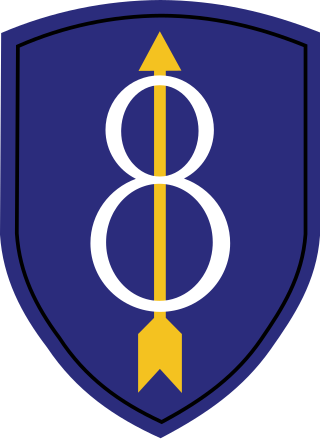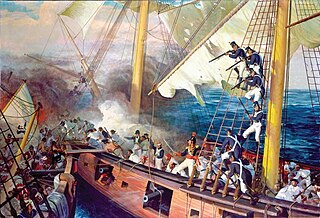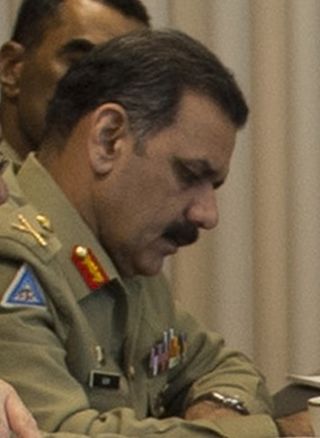The United States Armed Forces are the military forces of the United States. The armed forces consist of six service branches: the Army, Marine Corps, Navy, Air Force, Space Force, and Coast Guard. All six armed services are among the eight uniformed services of the United States, along with the U.S. Public Health Service Commissioned Corps and the NOAA Commissioned Officer Corps.

The Bangladesh Armed Forces are the military forces of the People's Republic of Bangladesh. They consist of the three uniformed military services: the Bangladesh Army, the Bangladesh Navy and the Bangladesh Air Force. The Armed Forces are under the jurisdiction of Ministry of Defence of the Government of Bangladesh, and are directly administered by the Armed Forces Division of the Prime Minister's Office. The President of Bangladesh serves as the Commander-in-Chief of the Bangladesh Armed Forces. Bangladesh has the third-largest defence budget in South Asia, The Bangladeshi military is the 37th strongest in the world and the third most powerful military force in South Asia. Border Guard Bangladesh and Bangladesh Coast Guard are under the jurisdiction of the Ministry of Home Affairs. during peacetime, but during wartime they fall under the command of Bangladesh Army and Bangladesh Navy respectively.

The Indian Army is the land-based branch and largest component of the Indian Armed Forces. The President of India is the Supreme Commander of the Indian Army, and its professional head is the Chief of Army Staff (COAS). The Indian Army was established on 1 April 1895 alongside the long established presidency armies of the East India Company, which too were absorbed into it in 1903. Some princely states maintained their own armies which formed the Imperial Service Troops which, along with the Indian Army formed the land component of the Armed Forces of the Crown of India, responsible for the defence of the Indian Empire. The Imperial Service Troops were merged into the Indian Army after independence. The units and regiments of the Indian Army have diverse histories and have participated in several battles and campaigns around the world, earning many battle and theatre honours before and after Independence.

The 8th Infantry Division, ("Pathfinder") was an infantry division of the United States Army during the 20th century. The division served in World War I, World War II, and Operation Desert Storm. Initially activated in January 1918, the unit did not see combat during World War I and returned to the United States. Some units would serve in the American Expeditionary Force to Siberia. Activated again on 1 July 1940 as part of the build-up of military forces prior to the United States' entry into World War II, the division saw extensive action in the European Theatre of Operations. Following World War II, the division was moved to West Germany, where it remained stationed at the Rose Barracks in Bad Kreuznach until it was inactivated on 17 January 1992.

The 9th Infantry Division is an inactive infantry division of the United States Army. It was formed as the 9th Division during World War I, but never deployed overseas. In later years it was an important unit of the U.S. Army during World War II and the Vietnam War. It was also activated as a peacetime readiness unit from 1947 to 1962 at Fort Dix, New Jersey, and Fort Carson, Colorado, and from 1972 to 1991 as an active-duty infantry division at Fort Lewis, Washington. The division was inactivated in December 1991.

The Parachute Regiment is an airborne and special forces regiment of the Indian Army. It was raised in 1945 as part of the British Indian Army but was disbanded after World War II and was re-raised in 1952 as part of the Indian Army. Currently it consists of fifteen Special Forces, two Territorial Army and one Rashtriya Rifles battalions.

The Pakistan Army, commonly known as the Pak Army, is the land service branch and the largest component of the Pakistan Armed Forces. The president of Pakistan is the supreme commander of the army. The Chief of Army Staff (COAS), a four-star general, commands the army. The Army was established in August 1947 after Pakistan gained independence from the United Kingdom. According to statistics provided by the International Institute for Strategic Studies (IISS) in 2024, the Pakistan Army has approximately 560,000 active duty personnel, supported by the Pakistan Army Reserve, the National Guard and the Civil Armed Forces. Pakistan Army is the sixth-largest army in the world and the largest in the Muslim world.

Marines are military personnel who primarily operate in littoral zones, both on land and at sea. Historically, the main tasks undertaken by marines have included raiding ashore in support of naval objectives, and the boarding of vessels during combat or capture of prize ships. Marines also help maintain discipline and order aboard the ship. In most countries, marines are an integral part of that state's navy; in some countries their marine forces can also instead be part of the land army, such as the French Troupes de Marine, or an autonomous branch such as the United States Marine Corps.

The Sri Lanka Army is the oldest and largest of the Sri Lanka Armed Forces. The army was officially established as the Ceylon Army in 1949, though the army traces its roots back in 1881 when Ceylon Light Infantry Volunteers was created; the army was renamed as the 'Sri Lanka Army' when Sri Lanka became a republic in 1972. In 2024, the Army had approximately 150,000 personnel.

Lieutenant General Sagat Singh, PVSM was a General Officer in the Indian Army, notable for his participation in the liberation of Goa and later in Indo-Pakistani war of 1971. He held many commands and staff appointments throughout his career.

The XI Corps of the Indian Army is based in Jalandhar and is a part of Western Command. XI Corps is also known as Vajra Corps.

The Eastern Command of the Pakistan Army was a corps-sized military formation headed by a lieutenant-general, who was designated the Commander Eastern Command. After the partition of India by United Kingdom, the Islamic Republic of Pakistan was divided into two territories separated by 1,000 miles (1,600 km). Most of the assets of the Pakistan armed forces were stationed in West Pakistan; the role of the Pakistan armed forces in East Pakistan was to hold that part of the country until the Pakistani forces defeated India in the west. The Pakistan Army created the Eastern Command, with one commander in the rank of Lieutenant General responsible for the command. The armed forces, had drawn up a plan to defend Dhaka by concentrating all their forces along the Dhaka Bowl.

The Eastern Command is one of the six operational commands of the Indian Army. It is headquartered in Fort William in the city of Kolkata in the state of West Bengal. The Eastern Command was formed on 1 November 1920. The Command is commanded by a three-star rank officer with the title General Officer Commanding-in-Chief (GOC-in-C).

General Raheel SharifNI(M) HI(M) LOM is a retired four-star army general of the Pakistan Army who served as the ninth chief of army staff from 29 November 2013 to 29 November 2016. After his retirement as Pakistan's army chief, he was appointed as the commander of the Islamic Military Counter Terrorism Coalition, a 41-nation alliance of Muslim countries headquartered in Riyadh, Saudi Arabia.

China–Pakistan Economic Corridor is a 3,000 km Chinese infrastructure network project currently under construction in Pakistan. This sea-and-land-based corridor aims to secure and shorten the route for China’s energy imports from the Middle East, avoiding the existing path through the Straits of Malacca between Malaysia and Indonesia, which could be blockaded in case of war, thereby threatening China’s energy-dependent economy. Developing a deep-water port at Gwadar in the Arabian Sea and establishing a robust road and rail network from this port to the Xinjiang region in western China would serve as a shortcut, enhancing trade between Europe and China. In Pakistan, the project aims to address electricity shortages, develop infrastructure, and modernize transportation networks, while also transitioning the economy from an agriculture-based structure to an industrial one.
Military exercises are conducted by the Pakistan Armed Forces to increase combat readiness, and to identify problems in logistics, training, and current military doctrine. They also test the ability of units to work together. Lastly, they act as a visible expression of military might, which acts as a deterrent to potential enemy action. An important component of each exercise is the after-action assessment. Since 1989 the four branches services have increasingly begun coordinated exercises.

Lieutenant General Asim Saleem BajwaHI(M) TBt is a retired Pakistani three-star general who served as the chairman of China-Pakistan Economic Corridor Authority from November 2019 to August 2021 and the special assistant to then Prime Minister Imran Khan on the Ministry of Information and Broadcasting from 28 April 2020 to 12 October 2020. On 11 December 2016, Bajwa was appointed as Inspector General Arms at GHQ, where he served until his appointment to the position of Commander Southern Command and XII Corps in September 2017. Previously, he also served as Director General of the ISPR from 2012 to 2016.

The Civil Armed Forces (CAF) are a group of nine paramilitary, uniformed organisations, separate and distinct from the regular "military" Pakistan Armed Forces. They are responsible for maintaining internal security, helping law enforcement agencies, border control, counter-insurgency and counter-terrorism, riot control, and anti-smuggling under the Ministry of Interior. They frequently operate alongside the Pakistani military in response to natural disasters. During times of war they can have their command transferred to the Ministry of Defence, and effectively combined to form a reserve force for the Pakistani military.
The Frontier Corps Khyber Pakhtunkhwa (South) (Urdu: سرحد واہنی خیبر پختونخواہ (جنوبی), reporting name: FCKP(S)), is a federal paramilitary force in Pakistan, operating in the southern part of Khyber Pakhtunkhwa province, to overseeing the country's borders with Afghanistan and assisting with maintaining law and order. It is one of four Frontier Corps with the others being: FC Khyber Pakhtunkhwa (North) stationed in the north of Khyber Pakhtunkhwa province, and FC Balochistan (North) and FC Balochistan (South) stationed in Balochistan province.
The Frontier Corps Khyber Pakhtunkhwa (North) (Urdu: فرنٹیئر کور خیبر پختونخواہ (شمالی), reporting name: FCKP(N)), is a federal paramilitary force in Pakistan, operating in the northern part of Khyber Pakhtunkhwa province, overseeing the country's borders with Afghanistan and assisting with maintaining law and order. It is one of four Frontier Corps with the others being: FC Khyber Pakhtunkhwa (South) stationed in the south of Khyber Pakhtunkhwa province, and FC Balochistan (North) and FC Balochistan (South) stationed in Balochistan province.














